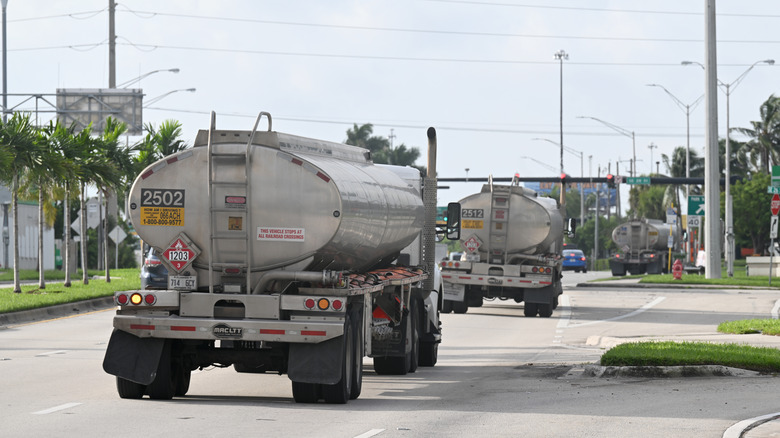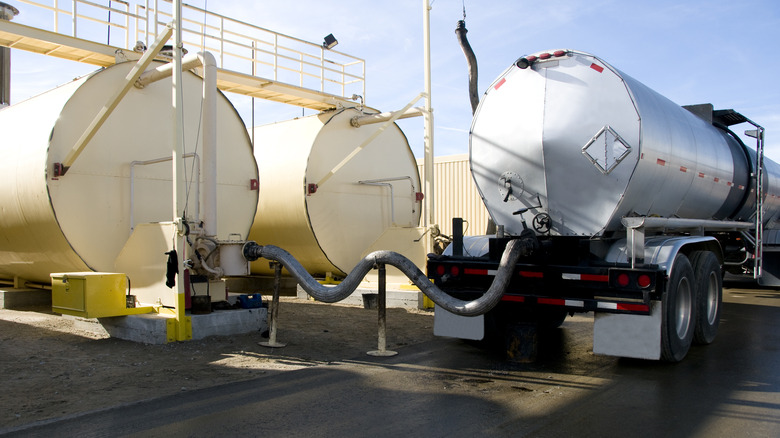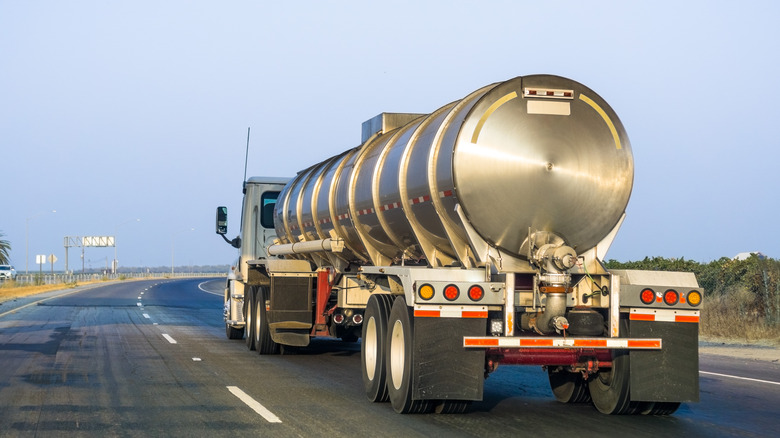This Is What The Inside Of A Tanker Truck Looks Like
Just as with any vehicle on the road, a wide range of safety features are implemented. It would be easy to picture the inside of a tanker truck as a sort of huge water bottle on wheels, but there's much more to it than that. One tanker truck's interior won't necessarily be the same as another's because each is tailored to different needs.
What you may find inside, though, are some sophisticated features to ensure the contents remain as still as possible, so they arrive at the delivery point safely. These tankers will often transport diesel fuel, which is potentially volatile and dangerous. Since road conditions are unpredictable at times, drivers have to keep the precious consignment of fuel from rushing forward in a great 'wave' when braking. As with any liquid, this can be a significant hazard.
Even a little movement on the road can translate to a lot of movement in a big, full container like this. To minimize the liquid's movement, baffles are installed inside the tank. These are barriers spread throughout the tanker, preventing liquid from rushing all the way from one end to the other. They're crucial to road safety because a dramatic shift in the weight distributed within the tanker could be enough to make it jackknife or turn the vehicle over entirely. They can also be compartmentalized in other ways, organized so as to be able to transport multiple kinds of cargo at once.
Other features of a tanker truck's interior
Another design priority is ensuring the body of the tank is durable and resistant to leaks as much as possible. With that in mind, partitions throughout serve to reinforce the tank's structure. Suttons Group, a UK-based logistics company that has operated a fleet of 40 44-tonne tankers, notes that its tankers are typically divided into six different compartments, and each can carry 'incompatible' cargo, such as gasoline and diesel, safely as they can be sealed and separated entirely. There is also the option to use the aforementioned baffles to allow freer movement for the cargo from one end of the tank to the other, but to control it in order to prevent any risk.
The simulation below, demonstrates that baffles, in this case resembling partitions with circular gaps in the center, control that force:
Filling and emptying a tanker is far more complex than simply filling up at the gas station. An inefficient operation can be costly, so great care is taken with these procedures. In most cases, the necessary valves to fill the tanker are located on the top, and wearing personal protective equipment (PPE) is essential for those tasked with the process of filling the tanker. There are also the chains on the back of tankers, another protective measure.
The types and quantities of cargo that a tanker truck can carry
Another vital safety concern that governs vehicles on the road is their weight. Their size will be tailored to their purpose and the routes they travel on. Some can be particularly enormous: In Australia, the 'Quad Trains,' four tankers connected together for efficiency and capacity, traverse up to four days to transport fuel from Darwin to Alice Springs, where the Fuel Trans depot is. With an odyssey like that, it's vital to transport as much as possible at a time, and in May 2023, Tiemans introduced the PBS Quad Train, the world's biggest.
This vehicle is 175 feet long and capable of carrying, according to Trailer Magazine, "...a payload of 157KL of diesel with mixed motor spirit and diesel products exceeding 160KL payload." Such a behemoth would not be suited for every transport duty, but sometimes it is necessary.
By contrast, in the U.K., Crown Oil's fleet ranges in size from the articulated twelve-wheelers that can hold 36,000 liters of fuel to its Baby Tankers, with a capacity of just 8,000 liters. These smaller tankers are designed to make deliveries to locations that much larger models couldn't hope to access. These vehicles aren't just fuel trucks, either. Specialized tankers equipped with cooling and double vacuum insulation, for instance, are used to transport such substances as liquid nitrogen, while tanks further reinforced with a protective lining can transport corrosive materials like acids.


